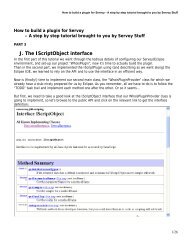Step by step tutorial: how to build a bean for Servoy - Servoy Stuff
Step by step tutorial: how to build a bean for Servoy - Servoy Stuff
Step by step tutorial: how to build a bean for Servoy - Servoy Stuff
Create successful ePaper yourself
Turn your PDF publications into a flip-book with our unique Google optimized e-Paper software.
How <strong>to</strong> <strong>build</strong> a <strong>bean</strong> <strong>for</strong> <strong>Servoy</strong> - A <strong>step</strong> <strong>by</strong> <strong>step</strong> <strong>tu<strong>to</strong>rial</strong> brought <strong>to</strong> you <strong>by</strong> <strong>Servoy</strong> <strong>Stuff</strong><br />
public void setToolTipText(String <strong>to</strong>olTipText) {<br />
this.<strong>to</strong>olTipText = <strong>to</strong>olTipText;<br />
if (component != null) {<br />
component.setToolTipText(<strong>to</strong>olTipText);<br />
}<br />
}<br />
public void setDataProviderID(String dataProviderID) {<br />
this.dataProviderID = dataProviderID;<br />
if (component != null) {<br />
component.setDataProviderID(dataProviderID);<br />
}<br />
}<br />
public void setTansparent(boolean tansparent) {<br />
this.tansparent = tansparent;<br />
if (component != null) {<br />
component.setOpaque(!tansparent);<br />
}<br />
}<br />
All these methods are <strong>build</strong> on the same principle, we s<strong>to</strong>re the value set <strong>by</strong> the user (from the<br />
Properties View Edi<strong>to</strong>r in <strong>Servoy</strong> Developer), then we check our component <strong>for</strong> null and <strong>for</strong>ward the<br />
value <strong>to</strong> it…<br />
The only one <strong>for</strong> which you actually need <strong>to</strong> think about a little is the setTransparent(), since we really<br />
only have an “opaque” property which is the exact contrary of “transparent” (isn’t it), we invert the<br />
boolean received be<strong>for</strong>e passing it <strong>to</strong> the setOpaque() method. No advanced Java <strong>to</strong>pics here!<br />
So it’s time <strong>to</strong> get back <strong>to</strong> our getBeanInstance() method, this method is called <strong>by</strong> <strong>Servoy</strong> when it<br />
wants <strong>to</strong> retrieve an instance of an object of type IComponent (that’s why it is called this way: it comes<br />
from a well know Object Oriented Pattern called the “Fac<strong>to</strong>ry” pattern, where an object is used <strong>to</strong><br />
produce instances of objects from a set of parameters, see GOF pattern – “Gang Of Four” on the web).<br />
So <strong>Servoy</strong> calls the method, and it sends 3 parameters <strong>to</strong> help us create the right kind of object:<br />
- int: is the type of client actually running, and we only need <strong>to</strong> test if this is the Web client, and<br />
we have a constant <strong>for</strong> that in the IClientAccessPlugin interface: WEB_CLIENT<br />
- IClientPluginAccess: the <strong>Servoy</strong> client (a reduced interface <strong>to</strong> it actually)<br />
- Object[]: and array of objects, which are parameters. As far as I know there is only one object<br />
in this array, it is <strong>Servoy</strong>’s UUID <strong>for</strong> the object as a String.<br />
So we implement our method like this:<br />
public IComponent getBeanInstance(int appMode,<br />
IClientPluginAccess paramIClientPluginAccess,<br />
Object[] paramArrayOfObject) {<br />
}<br />
String id = (String)paramArrayOfObject[0];<br />
if (appMode == IClientPluginAccess.WEB_CLIENT) {<br />
component = new WicketTestBean(id);<br />
initComponent();<br />
}<br />
return component;<br />
32/37



